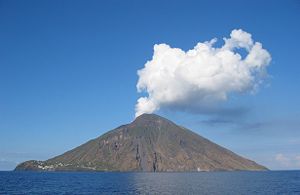Stromboli
| Mt. Stromboli | |
|---|---|
 |
|
| Elevation | 926 metres (3,038 ft) |
| Location | Aeolian Islands (Italy) |
| Type | Stratovolcano |
| Last eruption | August 2nd 2008 |
| Easiest route | Hike |
Stromboli (Greek: Strongyle) is a small island in the Tyrrhenian Sea, off the north coast of Sicily, containing one of the three active volcanoes in Italy. It is one of the eight Aeolian Islands, a volcanic arc north of Sicily. This name is a corruption of the ancient Greek name Στρογγυλή (Stroŋgulē) which was given to it because of its round swelling form. The island has a population of between 400 and 750. The volcano has erupted many times, and is constantly active with minor eruptions, often visible from many points on the island and from the surrounding sea. The last major eruption was in November 2007.
Stromboli stands 924 m (3,031 feet) above sea level,[1] but actually rises over 2,000 m (6,500 feet) above the sea floor. There are three active craters at the peak. A significant geological feature of the volcano is the Sciara del Fuoco ("Stream of fire"), a big horseshoe-shaped depression generated in the last 13,000 years by several collapses on the north western side of the cone.
Stromboli is remarkable because of the length of time for which it has been in almost continuous eruption. For at least the last 2,000 years, the same pattern of eruption has been maintained, in which explosions occur at the summit craters with mild to moderate eruptions of incandescent volcanic bombs at intervals ranging from minutes to hours. This characteristic Strombolian eruption, as it is known, is also observed at other volcanoes worldwide. Eruptions from the summit craters typically result in few second-lasting mild energetic bursts emitting ash, incandescent lava fragments and lithic blocks up to a few hundred meters high. Stromboli's activity is almost exclusively explosive, but lava flows do occasionally occur - an effusive eruption in 2002 was its first in 17 years.


The mildly explosive eruptions are also occasionally punctuated by much larger eruptions. The largest eruption of the last hundred years occurred in 1930, and resulted in the deaths of several people and the destruction of a number of houses by flying volcanic bombs. Large eruptions occur at intervals of years to decades, and the most recent large eruption began in 2002, causing the closure of the island to non-residents for several months. The eruption started with a lava flow (29 December 2002) along the "Sciara del Fuoco" flank that rapidly reached the sea. On 30 December 2002 a huge volume of rocks collapsed from the "Sciara del Fuoco" generating at least two landslides and many tsunami waves. The highest wave was 10 m high and caused serious damage at the Stromboli village. On 5 April 2003 a strong explosion from the summit crater ejected rocks that reached Ginostra village, damaging some houses. The eruption terminated on July 2003.
On 27 February 2007, two new craters opened on the island, with lava flowing into the sea from one of them.[2]
Contents |
In popular culture

- Stromboli is a dish similar to a calzone found in North American pizzerias. It is thought to have been named after the 1950 film and consists of top and bottom crusts containing a mix of sausage, meats, cheese, and vegetables.
- Stromboli is sometimes identified with Aeolia, the floating island described in Homer's Odyssey as home to Aeolus, the keeper of the winds.
- Stromboli is mentioned in John Evelyn's 1661 pamphlet 'Fumifugium, or, The inconvenience of the aer and smoak of London dissipated'.
- In Jules Verne's novel Journey to the Center of the Earth, Axel and Otto Lidenbrock emerge from their subterranean journey from the volcano on Stromboli.
- Stromboli is a villain in the Disney classic Pinocchio (1940).
- Stromboli is the title of a 1950 film starring Ingrid Bergman, shot on location on the island. She plays a World War II refugee who marries a local islander, but has difficulty adjusting to the harsh rural lifestyle. The red-painted house used for the film remains as a tourist attraction.[3]
- J. R. R. Tolkien is reported as likening Stromboli to "Emyn Anar" in Mordor from his The Lord of the Rings novel.[4]
- Nanni Moretti's film Caro Diario (Dear Diary) (1993) is partly set in Stromboli.
- The Book of the Dead (2006), by authors Douglas Preston and Lincoln Child, ends with a chase up the active volcano.
- In Discovery Channel's game show Cash Cab, Stromboli was the answer to the video bonus question: Located off the coast of Sicily, this active volcano has been erupting almost continuously for the last 2000 years. Lending its name to a calzone-like treat, what is the name of this Italian mountain of fire?[5]

See also
- List of volcanoes in Italy
References
- ↑ Smithsonian Institution Global Volcanism Program: Stromboli
- ↑ BBC NEWS | World | Europe | Volcanic Italian island on alert
- ↑ Stromboli (1950)
- ↑ Kilby, Clyde S; Plotz, Dick (1968), "Many Meetings with Tolkien: An Edited Transcript of Remarks at the December 1966 TSA Meeting", Niekas (Niekas Publications, New Hampshire, USA) (19): 39-40 Referred to at tolkienguide.com .
- ↑ Game Show News Net
External links
- Stromboli travel guide from Wikitravel
- Stromboli Online
- Photo gallery of Stromboli eruptions.
- Watch video of spectacular Strombolian eruption on 5th April 2006 (direct youtube link)
- Area Vesuvio
- Information about Stromboli and on its seismic monitoring network (italian)
- Live (30 min) Satellite Photo of Stromboli
- Live (3 min) Visible Light Webcam (SPV)
- Live (15 min) Infrared Webcam (SPI)
- Live (3 min) Visible Light Webcam (SQV)
- Live (15 min) Thermal Imaging Webcam (SQT)
- Italy's Volcanoes: The Cradle of Volcanology - Stromboli Online's sister site with detailed info on Italy's volcanoes, including Stromboli